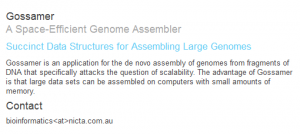
Gossamer - 'Succinct' data structure for efficient storage of de Bruijn graphs
In our comment section, reader Torsten Seemann (of Velvet Optimizer fame) mentioned an interesting paper on efficient storage of de Bruijn graphs that is worth mentioning. The paper is titled “Succinct data structures for assembling large genomes”, and it uses an entropy-compressed data structure to efficiently store de Bruijn graphs. Those with no patience to read paper can download their Gossamer software, and try it out.

The problem it solves is familiar to all bioinformaticians starting to work on NGS data. In a nutshell,
1. Mr. Bioinformatician worked on genome sequences for many years, but never saw data from high-throughput sequencing. Naturally, when he heard 512 Gigs, he thought of size of hard-drive, not RAM.
2. He received four large hiSeq files on a mystery genome or transcriptome from his collaborator Dr. Biologist.
3. He downloaded and installed a popular program (Velvet, ABySS, SOAPdenovo, Trinity), found instructions on how to run and tried on ‘mystery’ libraries. This was when the fun began. Very soon he found out that the real challenge of analyzing NGS data was in being able to process them efficiently within available computational resources. On ordinary (and even some extra-ordinary) servers, NGS programs ran out of memory space very fast.
Amateur solution is to remove reads arbitrarily and run the programs on smaller libraries to fit memory. That approach is inefficient, because it removes useful information by cutting signal and noise equally.
Smart researchers are pursuing five strategies to handle large volume of NGS data.
A. Hardware improvement - Buy a computer with large RAM (not scalable), use MPI or Hadoop (scalable).
B. Smart packing of de Bruijn graph into smaller memory/storage space - Gossamer fits into this category. Other approaches are discussed in Gossamer paper linked above.
C. Intelligent removal of reads - As an example, we discussed digital normalization approach by Titus Brown in an earlier commentary.
D. Intelligent removal of k-mers - In a forthcoming commentary, we will discuss a new paper on ‘SparseAssembler’.
Given that our last few commentaries were on Shannon’s research on information theory, it is worth mentioning that Gossamer reaches theoretically close to lowest bound on optimal storage by using entropy-compression. We did not get too much time to elaborate on the concept of entropy used in information theory in our commentary on ‘What is in the news’, but you can learn more about it from the web-pages linked from there.